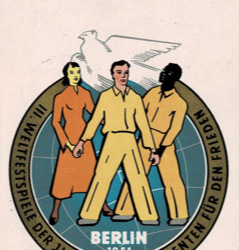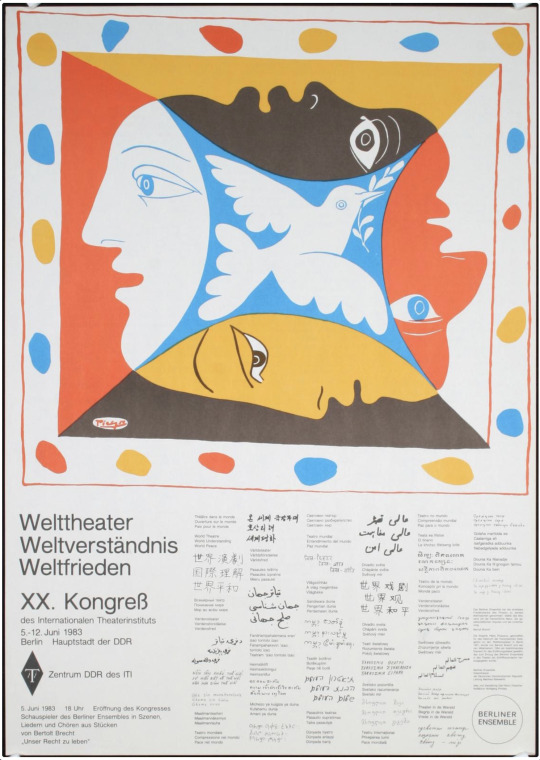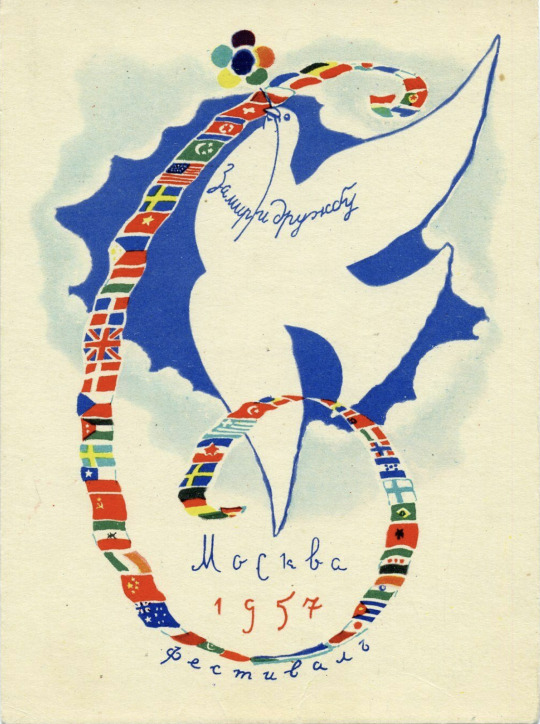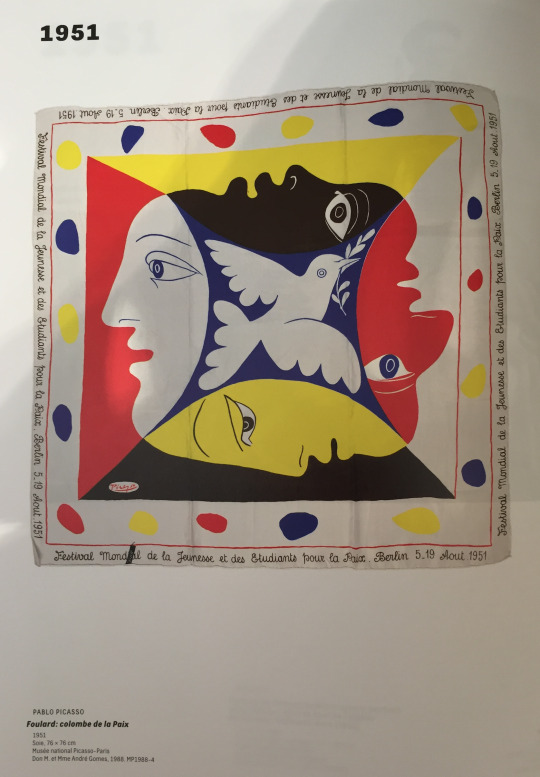Picasso's “Quatre Visages” Humanity Scarf: The Art of Peace
Don't wanna be here? Send us removal request.
Text
Maryse Masson
Maryse Masson (born March 21, 1934) was an active activist, since the Liberation, in youth movements (Vaillants, young girls of France, Union of Republican Youth of France) in her neighborhood and in her schools, particularly on issues of the fight for peace, for the Stockholm appeal. She participated in the preparation and the French delegation to the Youth Festival in Berlin in 1951. She joined the French Communist Party in 1950 under the name Masson-Martin.

Subscription List shown above displays a stamp of the Picasso Peace Scarf
0 notes
Text
Little School of Art
Spark creativity and develop artistic skills in this engaging art program designed for children aged 7-17, particularly homeschoolers.
This program offers a fun and stimulating environment for children to explore various artistic techniques and themes. With a focus on skill development and self-expression, young artists will:
Experiment with drawing, printmaking, collage, painting, and sculpting.
Engage with diverse artistic styles like self-portraiture, abstraction, surrealism, still life, and more.
Build confidence and enjoy the process of creative exploration.

Little School of Art: Term 1 Art Program for Kids Stanthorpe Regional Art Gallery 56 Lock Street Stanthorpe, QLD, 4380 Australia
0 notes
Text
Terracotta tile reproduction
Terracotta tile reproduction of the Picasso Peace Scarf. 34cm x 34cm x 2 cm deep. Purchased from Moinat based in Rolle, Switzerland in 2025.

0 notes
Text
Pierre Daix (1922 -2014)

The above photo of Pierre Daix with Picasso and Helen Parmelin (French novelist, journalist, and art critic) in 1954 is posted in the Paris Picassso Museum just outside the conference room that bears his name.
Pierre Daix wrote the following eloquent description of the Picasso's Peace Scarf when he was the Editor of Lettres Francaises:
"The Dove of Peace, a symbol whose origins are shrouded in the mists of ancient iconography, is giving new life and meaning in this design by Pablo Picasso. A dove, reduced to its essential form, carries the olive branch upward with powerful thrusts of its wings. The bird does not sit or float lazily on the updrafts of a warm and friendly world, but actively works to carry its message to an inimicable one.
The races of Man are painted in large, simple forms with a minimum of border distinction. In this way Picasso graphically illustrates his realization that human beings share a heritage and that it is the artificial definitions which have prevented the development of a truly universal brotherhood. The faces of Man, stylized representations of the Negro, Indian, Asian and Caucasian, form a square which embraces the brilliant blue shield upon which the dove flies. The forehead of one face becomes the chin of another at each corner, unifying the composition and the concept. Each profile is set against a color of another race, thus strengthening the composition and subtly unifying it. Free spots of color, picked up from the central square, are repeated in the border.
This is a joyful, hopeful picture which contrasts dramatically with the apocalyptic vision of war which Picasso thrust upon a shocked world in Guernica which is on loan from the artist to the Museum of Modem Art in New York City. "
Writer and Editor in Chief LETTRES FRANCAISES
Pierre Daix was born in Ivry-sur-Seine on May 24, 1922, and died in Paris on November 2, 2014. He studied at the Lycée Henri IV in Paris before his preparatory class was transferred to Rennes at the beginning of the Second World War. In 1939, he joined the French Communist Party (P.C.F.) and entered the Resistance from the Occupation. Arrested after the demonstration on November 11, 1940 on Place de l'Étoile, he was incarcerated in nine French prisons before being deported to Mauthausen in Austria. At the Liberation, he became head of the private secretariat of Charles Tillon, Minister of Air, Armaments and Reconstruction. From 1947, he worked at Éditions sociales and the communist daily Ce soir, of which he became editorial director. He was mainly, for nearly twenty years, from 1953 to 1972, editor-in-chief of French Letters to Louis Aragon.
0 notes
Text
Interior Decor
The elegant touch of an interior designers creativity - matching the curtains, throw pillow and table top lamp to the colors of the peace scarf.

0 notes
Text
The Pabloaf
One of the more unusual replicas of Picasso's famous peace scarf - the Pabloaf!

0 notes
Text
1951 Berlin Youth Festival

The 1951 Berlin Youth Festival was an international event that took place in East Berlin, Germany from July 25 to August 5, 1951. The festival was organized by the World Federation of Democratic Youth (WFDY), a communist-led international youth organization, and was hosted by the German Democratic Republic (East Germany).
The festival was attended by more than 26,000 young people from over 100 countries, including many countries that were behind the Iron Curtain at the time. The festival aimed to promote international solidarity, peace, and cultural exchange among young people from around the world.
The festival included a wide range of cultural and sporting events, such as concerts, dances, theater performances, and athletic competitions. The festival also included political events, such as speeches and discussions on issues related to peace, democracy, and socialism.
The 1951 Berlin Youth Festival was a highly politicized event that reflected the Cold War tensions of the time. The festival was seen by many in the West as a propaganda tool of the Soviet Union and its allies, and was criticized for promoting communist ideology and political propaganda.
Despite these criticisms, the 1951 Berlin Youth Festival was seen as a major success by many participants, who valued the opportunity to meet and interact with young people from around the world and to learn about different cultures and political systems. The festival helped to promote international understanding and cooperation among young people, and it remains an important symbol of international solidarity and cultural exchange during the Cold War era.
Content courtesy of Chat GPT
0 notes
Text
About the Peace Scarf
At the age of 70, in 1951 Pablo Picasso created a peace scarf for the 5,000 young communists that were headed in early August to the 3rd International Youth Festival in Berlin. It was almost a square meter and shows his white peace dove surrounded by the half moon profiled faces of the 4 continents (Europe, America, Asia, Africa) European, African, Asiatic, and American Indian features. In handwriting on its borders it says, “Festival Mondial de la Jeunesse et des Etudiants Pour la Prix, Berlin 5-19 Aout 1951. The Peace Scarf was printed on cotton and silk, signed by Picasso, and sold for 450 francs at the Jeunesse Montmartre office.

The Cold War between the Soviet Union and Western democracies was in full swing in 1951 and Picasso believed in a post World War 2 world that communism held out a greater promise for peace than Western democracies. As a result he agreed to do this scarf for this youthful communist parade and party that was held in Berlin in August of 1951.
The peace scarf he designed for the 1951 Berlin Youth Festival was a significant piece of art that symbolized peace and unity. The scarf featured Picasso's iconic dove of peace, a motif he popularized as a representation of hope and reconciliation in the aftermath of World War II. The festival itself was an event aimed at promoting peace and friendship among youth from different countries, making Picasso's contribution particularly poignant. The scarf not only served as a fashion item but also as a powerful statement for the global peace movement during the Cold War era.
0 notes
Text
Origin of the Peace Scarf Design Elements
Picasso's artistic promotion of a dove for peace began at the 1949 Paris Peace Conference, reflecting his personal interest in peace for all of humanity. At the 1949 Peace Conference Picasso met Paul Roberson and became aware of the challenges of the black population - as well as Asian and Indian leaders. His 1951 Berlin peace scarf was the aggregation of his symbols for peace with the dove at the center surrounded by the four different human races.
When Picasso signed the Nice “Peace scarf against atomic weapons in 1950” he realized the popularity of peace scarves for young people - a revelation that probably led him to design the peace scarf for the Berlin youth festival in 1951.
In the photo shown below Picasso is signing the 1950 Peace Rally scarf for girl members attending the Communist sponsored International Youth for Peace rally in Nice, France. The young girl with her hand on the table is Alice Hornung, now 86, living in Germany and still active in the peace movement. According to Alice: “we weren't art connoisseurs, we were young people who worked for peace. All had had war experiences in their families or in their own lives. We were shocked by the consequences of the atomic bombing of Hiroshima and Nagasaki. Our aim was to do something for peace. Suddenly we were greeted by the great Picasso, whom the whole world worshiped - an amazing experience.”


Picasso Signs for Commies These girl members of the German Communist youth organization, attending the Communist sponsored International Youth for Peace rally at Nice, France, don't seem to mind going against the party line as they push and shove to get Pablo Picasso's autograph. Not only has the Communist Party denounced autograph hunting as "a decadent capitalistic pastime”, it has also labeled Picasso’s ultra-modern art as "the product of corrupt capitalism.”Above photo caption is from from the Palo Alto, CA Peninsula-Times Tribune (August 22, 1950).
Note: According to Julia Friedrich, curator of the Picasso Shared and Divided exhibit at the Museum Ludwig “The communist youth delegation (FDJ) came from Saarland, which did not belong to Germany before the Saar referendum 1955. I'm pretty sure these young people didn’t go against the party line.”

The Nice peace scarf (shown in detail above) from the Picasso signing newspaper photo. This unique scarf was signed by Pablo Picasso, French journalist Pierre Abraham, French Communist party leader Jean Kanapa, French naval officer Louis de Villefosse, Surrealist movement founder Paul Eluard, French novelist Dominique Desanti, French resistance leader André Verdet, British trade union leader Ken Gill (see his video on this site), French- Armenian poet Reuben Melik, German author Stephan Hermlin, Dutch documentary film maker Joris Ivens, and Nobel Prize winning Pablo Neruda. The scarf has multiple dedications to Lucienne Tilman (1918 - 1977). Organized by the Mouvement de la Paix, for “prohibition of atomic weapons”. This cloth scarf was made for the International Youth Meetings from August 13 - 20, 1950.
Scarf from the van Zuiden Picasso Scarf Collection

Shown above: Vintage 1950 Second World Congress of the Partisans of Peace scarf with white dove designed by Pablo Picasso. Made from a crepe silk.
0 notes
Text
About Pablo Picasso

Pablo Picasso (1881 - 1973) was undoubtedly the most famous artist of the twentieth century. During his artistic career, which lasted more than 75 years, he created thousand of works using all kind materials, parenting, sculptures, prints, and ceramics. He almost single-handedly created modern art. Picasso pioneered virtually every revolution in European art and fathered American abstract art, which discarded its reliance on subject matter but which is based on his techniques and forms. He changed art more profoundly than any other artist of this century. First famous for his pioneering role in Cubism, Picasso continued to develop his art with a pace and vitality comparable to the accelerated technological and cultural changes of the twentieth century. Each change embodied a radical new idea, and it might be said that Picasso lived several artistic lifetimes.
Picasso's styles are so diverse that they change not only from decade to decade but from day to day. His creative mentality enables him to creat a soothing mother and child in a monumental classical style bathed in pastels, as well as twisting, crudely angular, multifaceted and stridently colored female who is torturously complex. The inspiration for both paintings in the same woman. To Picasso this is not an anomaly, for he sees that every living person is a combination of opposing forces.
He has said the is belief is in existing itself, which gives him a limitless setting from which to draw his ideas. He does not understand beauty in concepts of a setting sun over lush fields ready for harvest or sophisticated personages sitting in splendid elegance. His curiosity, hence, his art, includes the most commonplace as well as the most spectacular and marvelous manifestations of life.
To use Picasso's often quote words: "I paint not what I see, I paint what I know." His greatness lies in his ability to formalize his finding into comprehensible visual terms.
Pablo Picasso was born on October 25, 1881, in Málaga, Spain. The son of an academic painter, José Ruiz Blasco, he began to draw at an early age. In 1895 the family moved to Barcelona, and Picasso studied there at La Lonja, the academy of fine arts. His visit to Horta de Ebro from 1898 to 1899 and his association with the group at the café Els Quatre Gats in about 1899 were crucial to his early artistic development. Picasso’s first exhibition took place in Barcelona in 1900, and that fall he went to Paris for the first of several stays during the early years of the century. Picasso settled in Paris in April 1904, and his circle of friends soon included Guillaume Apollinaire, Max Jacob, Gertrude and Leo Stein, as well as two dealers, Ambroise Vollard and Berthe Weill.
His style developed from the Blue Period (1901–04) to the Rose Period (1905) to the pivotal work Les Demoiselles d’Avignon (1907), and the subsequent evolution of Cubism from an Analytic phase (ca. 1908–11) to its Synthetic phase (beginning in 1912–13). Picasso’s collaboration on ballet and theatrical productions began in 1916. Soon thereafter, his work was characterized by neoclassicism and a renewed interest in drawing and figural representation. In the 1920s the artist and his wife, Olga (whom he had married in 1918), continued to live in Paris, to travel frequently, and to spend their summers at the beach. From 1925 to the 1930s Picasso was involved to a certain degree with the Surrealists, and from the fall of 1931 he was especially interested in making sculpture. In 1932, with large exhibitions at the Galeries Georges Petit, Paris, and the Kunsthaus Zürich, and the publication of the first volume of Christian Zervos’s catalogue raisonné, Picasso’s fame increased markedly.
By 1936 the Spanish Civil War had profoundly affected Picasso, the expression of which culminated in his painting Guernica (1937, Museo Nacional Centro de Arte Reina Sofía, Madrid). Picasso’s association with the Communist Party began in 1944. From the late 1940s he lived in the south of France. Among the enormous number of exhibitions that were held during the artist’s lifetime, those at the Museum of Modern Art, New York, in 1939 and the Musée des Arts Décoratifs, Paris, in 1955 were most significant. In 1961 the artist married Jacqueline Roque, and they moved to Mougins. There Picasso continued his prolific work in painting, drawing, prints, ceramics, and sculpture until his death on April 8, 1973.
0 notes
Text
International Theater Institute World Congress, 1983
The 20th ITI Congress was held in Berlin from June 5-12, 1983. The theme was "World Theatre - World Understanding - World Peace." and the promotional poster for this congress used Picasso's 1951 Berlin Peace Scarf (see below).
International Theater Institute, ITI, was created on the initiative of the first UNESCO Director General, Sir Julian Huxley, and the playwright and novelist JB Priestly, in 1948, just after the Second World War. This was the beginning of the Cold War, when the Iron Curtain divided East and West. The aim of the founders of ITI was to build a cultural organization for the performing arts that was aligned with UNESCO’s goals on culture, education, the arts, mutual understanding and peace. It focused its endeavors on improving the status of all members of the performing arts professions. They envisaged an organization that created platforms for international exchange and for engagement in the education of the performing arts, for beginners and professionals alike, as well as using the performing arts for mutual understanding and peace.
ITI has now developed into the world’s largest organization for the performing arts, with more than 90 centers spread across every continent.

0 notes
Text
Moscow, 1957: The Sixth Youth Festival ‘Dove Of Peace’ - Colombe De La Paix’, Silkscreen On Scarf

This linen scarf shown above was designed by Picasso to commemorate the Global Festival of Youth held in Moscow in 1957.
The 6th World Festival of Youth and Students opened in Moscow on the 28th of July 1957. It was of great importance historically as it marked the first time the Soviet Union had opened up its doors to the rest of the world under the bold political changes initiated by Nikita Khrushchev. The Luzhniki Sports Complex, Druzhba Park, Tourist Hotel Complex, Hotel Ukraina and Leninskiye Gory (today’s Vorobyovy Gory) metro station were all built for the festival. Themed flags and placards lined the city. The festival’s main symbol was Pablo Picasso’s famous drawing Dove of Peace, and the emblem was a flower with five petals symbolizing the continents. The foreign policy of the USSR was characterized by tension: the Cold War had been going on for 10 years. Receiving guests from across the globe, the Soviet Union was to demonstrate openness, friendliness and modernity. That wasn’t a difficult task at the height of the short and bright period of the Khrushchev Thaw, a time of creative freedom, great scientific discoveries, new music, new filmmaking and a new way of life, design, style and fashion.


Additional scarves from the 1957 Moscow Festival of Youth depicting Picasso's doves and the flags of the participating nations.
0 notes
Text
Vienna Youth Festival, 1959
Picasso repeatedly created designs for humanitarian and democratic organizations. The peace scarf he created for the 7th World Festival of Youth and Students, which took place in Vienna in 1959, features hands and doves in blue on creamy color background. This design was later used as a postcard design for the 8th World Festival of Youth and Students for Peace and Friendship, Helsinki, Finland, July 27 to August 5th, 1962.
Youth festival slogan: “For Peace and Friendship and peaceful coexistence”

0 notes
Text
Exhibitions and Museum Displays of the Peace Scarf





The peace scarf has been on display over the years in numerous museums, including the Picasso Museum in Paris, the Musee Municipal d'Art et d'Histoire de la Ville de Saint-Denis.
Picasso Museum, Picasso!, 2015
London Tate, Peace and Freedom Exhibit, 2010
Italy Venice, Il Tempo de la Pace, 2006 (also on exhibit book cover)
St. Tropez, Picasso, Choice of a Collector, 2019
Museum Ludwig, 2021-2022, Collogne, Germany (image at top)
Tapestry Museum
St. Denis Museum
Kunstmuseum Heidenheim, Germany
Melbourne Winter Masterpieces Exhibition 2022: The Picasso Century (image at the bottom)
0 notes
Text
World Federation of Democratic Youth (WFDY) World Festival of Youth and Students

The peace scarf (or variants of the races of humanity and dove theme) was used again in several subsequent peace festivals and congresses.
The World Federation of Democratic Youth (WFDY) is an international youth organization, recognized by the United Nations as an international youth non-governmental organization, and has historically characterized itself as anti-imperialist and left-wing. WFDY was founded in London in 1945 as a broad international youth movement, organized in the context of the end of World War II with the aim of uniting youth from the Allies behind an anti-fascist platform that was broadly pro-peace, anti-nuclear war, expressing friendship between youth of the capitalist and socialist nations. The WFDY Headquarters are in Budapest, Hungary. The main event of WFDY is the World Festival of Youth and Students. The last festival was held in Sochi, Russia, in October 2017. It was one of the first organizations granted general consultative status with the United Nations Economic and Social Council.
1 note
·
View note
Text
Codello “Quatre Visages” Silk Scarf, 1950

Original silkscreen print on silk, circa 1950, signed by Picasso with a printed signature, attached is a label showing the brand as “Codello”. Note the resemblance of these faces to the Quatre Visages ceramic plates as a precursor design for the Berlin Peace Scarf.
Size: 51 x 51.5 cms Note: Codello is a prominent Fashion brand which makes ladies scarves. It was founded by Rinaldo Codello, who was originally from Turin and moved his design house in the 1920’s to Munich.
1 note
·
View note
Text
Commemorative Postal Issues of the 1951 Berlin Youth Festival and Pablo Picasso



These are all commemorative postal issues from countries that directly supported the 3rd Worth Youth Festival in Berlin - Germany, China, and Romania. The commemorative Russian postage stamp of Picasso and his Peace Dove (shown below) was printed 100 years after his birth.

Commemorative covers and postal stamps from the van Zuiden Picasso Peace Scarf collection
0 notes